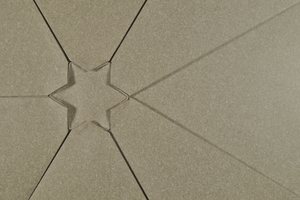Epiphany V

This year’s model of the Star of Bethlehem for Epiphany is based on my Star of David I molecule. The model as a whole is very similar to Epiphany III, the difference being the star and its tail are formed by negative space (the tail is also attached to the star in a slightly different way).
This design gave me a lot of trouble when I tried to construct its clean precrease using only origami methods. I was able to do it for the box with Star of David I because the box was folded from a hexagon, whose edges I could use as references. Folding from a rectangle made it much harder, and I realized I could probably not avoid precreasing at least the three axes of the hexagon in the center of the star.
So, I devised a different technique. I will probably write a separate post about it, but the underlying idea is very simple: first I precreased the model on a separate sheet using the full grid (which was easy), and then scored over this precreased sheet in order to copy the creases that are actually folded in the final model onto the target sheet. While not a pure origami method, it still uses only hand tools, so I think it is purer than printing out the crease pattern using a printer or scoring machine. Not needing such advanced devices is an advantage since not everyone has access to them, and it works for a much broader array of paper types and sizes than such devices can handle.
Comments